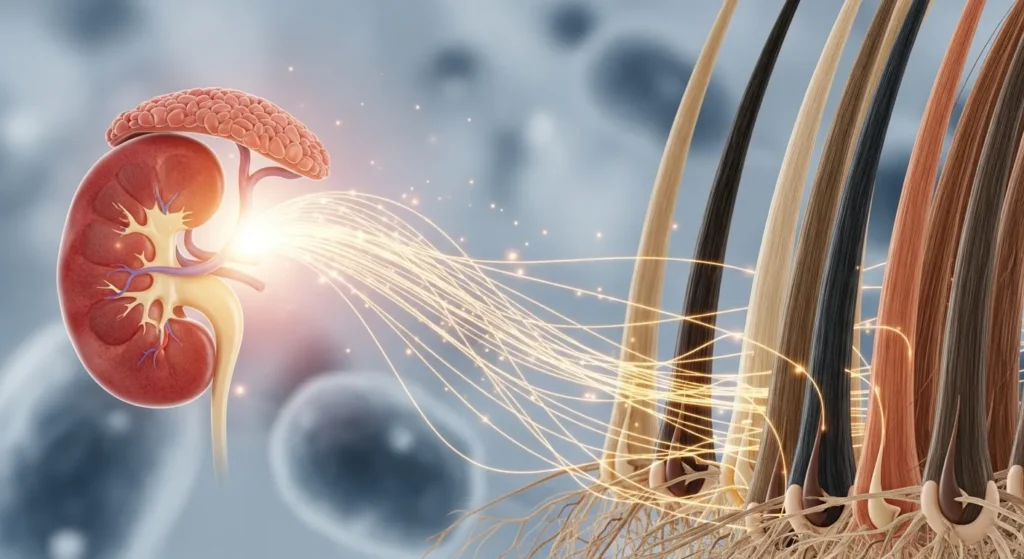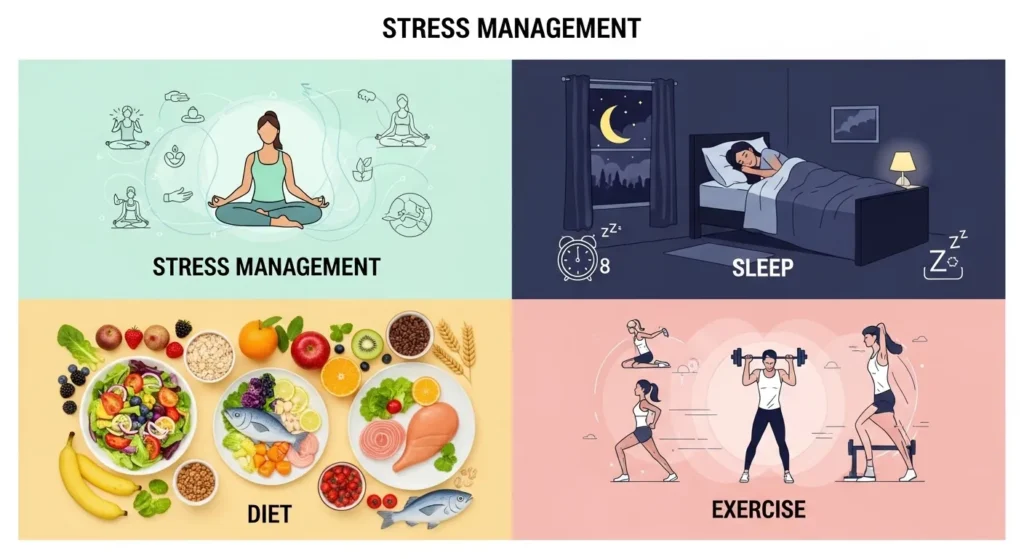Worried your hair is thinning and wondering if your adrenal glands are to blame? In this guide on adrenals and hair loss, we’ll explain how imbalances in cortisol, DHEA, and androgens can disrupt your hair growth.
You’ll learn which adrenal disorders cause shedding, how stress plays a role, and proven steps to restore hair health. Backed by medical insights and expert recommendations, this article gives you clear, credible answers—so you can act with confidence.
Understanding the Adrenal–Hair Connection

What the Adrenal Glands Do—Cortisol, DHEA, Androgens
Your adrenal glands are two small organs sitting atop your kidneys. Despite their size, they are hormone powerhouses, producing:
- Cortisol – your primary stress hormone
- DHEA – a precursor for testosterone and estrogen
- Androgens – hormones that influence body hair and scalp hair
These hormones don’t just control stress—they also regulate metabolism, immune response, and hair follicle activity.
How Hormone Imbalance Disrupts the Hair Growth Cycle
Hair grows in cycles: anagen (growth), catagen (transition), and telogen (resting). Chronic stress or adrenal disorders can:
- Shorten the anagen phase, causing early shedding
- Trigger telogen effluvium, where more hairs enter the resting phase
- Alter androgen levels, leading to male or female pattern thinning
Key Adrenal Conditions Linked to Hair Loss
Cushing’s Syndrome – Excess Cortisol → Thinning, Baldness, Hirsutism
When cortisol levels stay abnormally high, as in Cushing’s syndrome, the hair follicle’s growth phase is disrupted. Symptoms include:
- Diffuse scalp thinning
- Possible bald spots
- Excess facial or body hair in women
Treatment focuses on lowering cortisol, which may allow hair recovery over several months.
Addison’s Disease & Adrenal Insufficiency – Low DHEA → Body Hair Loss
Low adrenal output reduces DHEA and androgens. In women, this often means:
- Loss of pubic and underarm hair
- Thinning scalp hair
- Fatigue and low immunity
Hormone replacement therapy can restore balance and may improve hair density.
Congenital Adrenal Hyperplasia – Androgen Excess and Hair Changes
This genetic condition leads to overproduction of androgens, which can cause:
- Early-onset scalp hair thinning
- Excessive body hair growth (hirsutism)
Treatment involves medication to balance hormone production.
Adrenal Fatigue (Controversial)
Some practitioners use the term “adrenal fatigue” to describe chronic stress–related hormone dysregulation. While not recognized as a formal medical diagnosis, prolonged stress can still trigger cortisol–related hair shedding.
Stress, Cortisol, and Hair Loss Mechanisms
Telogen Effluvium & Hair Cycle Disruption
Under stress, your adrenal glands release cortisol. Excess cortisol can:
- Push follicles into the telogen phase
- Delay re-entry into the growth phase
- Causes noticeable shedding 2–3 months after stress peaks
Hormonal Cascade—High Cortisol, Low DHEA, Inflammatory Cytokines
High cortisol suppresses DHEA and sex hormones, altering the scalp environment. At the same time, inflammatory molecules can damage hair follicles, further reducing density.
Diagnosis & Testing
Lab Tests: Cortisol (Blood, Saliva, Hair), DHEA Ratios
If adrenal imbalance is suspected, a doctor may recommend:
- Morning blood cortisol
- 24-hour urinary cortisol
- Salivary cortisol rhythm test
- DHEA-sulfate levels
A balanced DHEA-to-cortisol ratio supports healthy hair growth.
When to Consult an Endocrinologist or Dermatologist
Seek professional advice if you notice:
- Rapid hair loss with fatigue, weight changes, or skin changes
- Loss of body hair in women
- Hair loss alongside high stress or hormonal symptoms
Treatment & Recovery Strategies
Medical Treatments by Condition
- Cushing’s syndrome: Surgery, radiation, or medication to reduce cortisol
- Addison’s disease: Hormone replacement therapy (hydrocortisone, fludrocortisone, DHEA)
- Congenital adrenal hyperplasia: Corticosteroids to balance androgen production
Lifestyle Interventions: Stress Management, Sleep, Diet, Exercise
- Stress reduction: Meditation, breathing exercises, gentle yoga
- Sleep hygiene: 7–9 hours nightly to stabilize cortisol rhythms
- Balanced nutrition: Protein, omega-3s, vitamins A, D, E, and biotin
- Exercise: Moderate activity to regulate hormones without overtraining

Recovery Timeline Chart / Case Study
| Condition | Hormone Correction | Hair Recovery Timeline* |
|---|---|---|
| Cushing’s | 3–6 months | 6–12 months |
| Addison’s | 1–3 months | 4–9 months |
| Stress-related | Immediate stress control | 3–6 months |
Timelines vary based on treatment adherence and overall health.
FAQ
Can adrenal problems cause hair loss?
Yes. Both overactive and underactive adrenal glands can disrupt hormones critical for hair growth.
How long until hair regrows after cortisol levels normalize?
Most people notice improvement within 3–6 months, but full density may take up to a year.
What is the DHEA-to-cortisol ratio?
It’s a measure comparing your stress hormone (cortisol) to your regenerative hormone (DHEA). An imbalance can signal adrenal stress.
Can stress-related hair loss become permanent?
If addressed promptly, it’s often reversible. Chronic, untreated imbalance may cause lasting follicle damage.
Next Steps
If you’re experiencing unexplained hair loss along with fatigue, mood changes, or body hair changes, your adrenal health might be the missing link. Book a consultation with Dr. Rana Irfan in Islamabad today to receive expert diagnosis, hormone testing, and a tailored treatment plan to restore your hair’s health and confidence.
